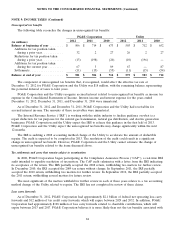PG&E 2012 Annual Report Download - page 89
Download and view the complete annual report
Please find page 89 of the 2012 PG&E annual report below. You can navigate through the pages in the report by either clicking on the pages listed below, or by using the keyword search tool below to find specific information within the annual report.NOTES TO THE CONSOLIDATED FINANCIAL STATEMENTS (Continued)
NOTE 9: INCOME TAXES (Continued)
the federal operating loss, charitable contributions, and tax credits can be realized within the carry forward periods,
therefore no valuation allowance was recognized as of December 31, 2012. As of December 31, 2012, PG&E
Corporation had approximately $19 million of federal net operating loss carry forwards related to the tax benefit on
employee stock plans that would be recorded in additional paid-in capital when used.
NOTE 10: DERIVATIVES
Use of Derivative Instruments
The Utility uses both derivative and non-derivative contracts in managing its customers’ exposure to commodity-
related price risk, including:
• forward contracts that commit the Utility to purchase a commodity in the future;
• swap agreements and futures contracts that require payments to or from counterparties based upon the
difference between two prices for a predetermined contractual quantity; and
• option contracts that provide the Utility with the right to buy a commodity at a predetermined price and
option contracts that require payments from counterparties if market prices exceed a predetermined price.
These instruments are not held for speculative purposes and are subject to certain regulatory requirements.
Customer rates are designed to recover the Utility’s reasonable costs of providing services, including the costs related
to price risk management activities.
Price risk management activities that meet the definition of derivatives are recorded at fair value on the
Consolidated Balance Sheets. As long as the current ratemaking mechanism discussed above remains in place and
the Utility’s price risk management activities are carried out in accordance with CPUC directives, the Utility expects
to recover fully, in rates, all costs related to derivatives. Therefore, all unrealized gains and losses associated with the
change in fair value of these derivatives are deferred and recorded within the Utility’s regulatory assets and liabilities
on the Consolidated Balance Sheets. (See Note 3 above.) Net realized gains or losses on commodity derivatives are
recorded in the cost of electricity or the cost of natural gas with corresponding increases or decreases to regulatory
balancing accounts for recovery from or refund to customers.
The Utility elects the normal purchase and sale exception for eligible derivatives. Derivatives that require
physical delivery in quantities that are expected to be used by the Utility over a reasonable period in the normal
course of business, and do not contain pricing provisions unrelated to the commodity delivered are eligible for the
normal purchase and sale exception. The fair value of derivatives that are eligible for the normal purchase and sales
exception are not reflected in the Consolidated Balance Sheets.
Electricity Procurement
The Utility enters into third-party power purchase agreements for electricity to meet customer needs. The
Utility’s third-party power purchase agreements are generally accounted for as leases, but certain third-party power
purchase agreements are considered derivatives. The Utility elects the normal purchase and sale exception for
eligible derivatives.
A portion of the Utility’s third-party power purchase agreements contain market-based pricing terms. In order to
reduce volatility in customer rates, the Utility may enter into financial swap and/or financial option contracts to
effectively fix and/or cap the price of future purchases and reduce cash flow variability associated with fluctuating
electricity prices. These financial contracts are considered derivatives.
Electric Transmission Congestion Revenue Rights
The California electric transmission grid, controlled by the California Independent System Operator (‘‘CAISO’’),
is subject to transmission constraints when there is insufficient transmission capacity to supply the market. The
CAISO imposes congestion charges on market participants to manage transmission congestion. The revenue
generated from congestion charges is allocated to holders of congestion revenue rights (‘‘CRRs’’). CRRs allow
market participants to hedge the financial risk of CAISO-imposed congestion charges in the day-ahead market. The
85
























